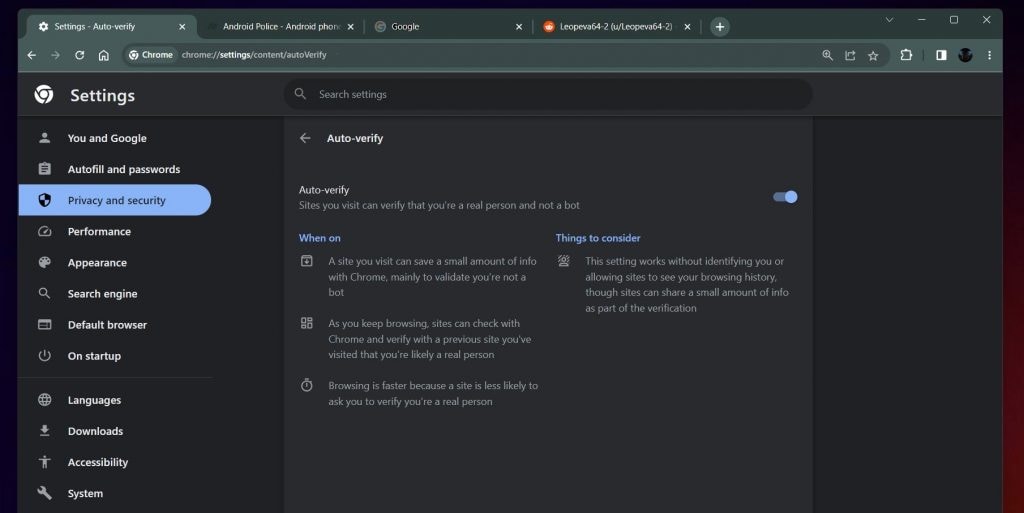You can try out this neat Google Chrome CAPTCHA bypass now!
Google Chrome, the most popular browser in the world has finally found a way to bypass CAPTCHA for you. So far, CAPTCHA is one of the most irritating security features of the internet. However, now that ChatGPT also beat the test, it’s about time humans found a way.
Enter Google Chrome’s “Auto-verify” page. Chrome is testing a new setting which will require you to prove that you’re human just once. After this one time, it will tell the CAPTCHAS on other sites you visit that you are a human. In other words, no need to tick all the buses and bikes and sidewalks again and again. Do it once, and then let Chrome do it for you.
How does Google Chrome prove you’re human?
Google Chrome is testing a new Auto-Verify page in the Privacy and security options. The option is still in the testing stage, so you will need to download Canary for desktop, a more advanced browser from Google where new features are tested before rolling out to Chrome.
Google has quietly added a new “Auto-verify” page in Chrome Settings, Chromium developers call this feature “anti-abuse” and it was added in February, but I haven’t seen it mentioned anywhere:https://t.co/OBYo9b3h9r pic.twitter.com/xhVqyaqpnH
— Leopeva64 (@Leopeva64) April 29, 2023
LeoPeva64 spotted the feature and tweeted about it. The tweet also has a link to a Chromium resource page that shows the working of the feature.
Once you download Canary, simply go to Settings > Privacy and security> Auto-verify > and toggle it on. Start browsing the web, and sooner or later you will come across a CAPTCHA. Once you verify you are a human, Canary will save a cookie-like token as proof of your humanity.
Now, anytime a site wants to send you a CAPTCHA for verification, your browser will show it the proof it stored earlier, and automatically verify you as human. The feature’s page also says that the sites that get this data are not allowed to see your browsing history. However, some amount of data is shared in order to bypass the CAPTCHA.
According to a Cloudflare blog, humans waste around 500 years per day on CAPTCHAS. So, the new Chrome feature will save the time and effort that is usually wasted on checking all boxes showing a bus.
However, Chrome Auto-verify is only available for desktops at the time of writing this story. Users will have to wait for it to come to Android, and then to Chrome’s stable version. All of this is likely to take several months, so feel free to download Canary and browse a CAPTCHA-free internet.
The post You can try out this neat Google Chrome CAPTCHA bypass now! appeared first on Techlusive.

Google Chrome, the most popular browser in the world has finally found a way to bypass CAPTCHA for you. So far, CAPTCHA is one of the most irritating security features of the internet. However, now that ChatGPT also beat the test, it’s about time humans found a way.
Enter Google Chrome’s “Auto-verify” page. Chrome is testing a new setting which will require you to prove that you’re human just once. After this one time, it will tell the CAPTCHAS on other sites you visit that you are a human. In other words, no need to tick all the buses and bikes and sidewalks again and again. Do it once, and then let Chrome do it for you.
How does Google Chrome prove you’re human?
Google Chrome is testing a new Auto-Verify page in the Privacy and security options. The option is still in the testing stage, so you will need to download Canary for desktop, a more advanced browser from Google where new features are tested before rolling out to Chrome.
Google has quietly added a new "Auto-verify" page in Chrome Settings, Chromium developers call this feature "anti-abuse" and it was added in February, but I haven't seen it mentioned anywhere:https://t.co/OBYo9b3h9r pic.twitter.com/xhVqyaqpnH
— Leopeva64 (@Leopeva64) April 29, 2023
LeoPeva64 spotted the feature and tweeted about it. The tweet also has a link to a Chromium resource page that shows the working of the feature.
Once you download Canary, simply go to Settings > Privacy and security> Auto-verify > and toggle it on. Start browsing the web, and sooner or later you will come across a CAPTCHA. Once you verify you are a human, Canary will save a cookie-like token as proof of your humanity.
Now, anytime a site wants to send you a CAPTCHA for verification, your browser will show it the proof it stored earlier, and automatically verify you as human. The feature’s page also says that the sites that get this data are not allowed to see your browsing history. However, some amount of data is shared in order to bypass the CAPTCHA.
According to a Cloudflare blog, humans waste around 500 years per day on CAPTCHAS. So, the new Chrome feature will save the time and effort that is usually wasted on checking all boxes showing a bus.
However, Chrome Auto-verify is only available for desktops at the time of writing this story. Users will have to wait for it to come to Android, and then to Chrome’s stable version. All of this is likely to take several months, so feel free to download Canary and browse a CAPTCHA-free internet.
The post You can try out this neat Google Chrome CAPTCHA bypass now! appeared first on Techlusive.
Google Chrome, the most popular browser in the world has finally found a way to bypass CAPTCHA for you. So far, CAPTCHA is one of the most irritating security features of the internet. However, now that ChatGPT also beat the test, it’s about time humans found a way.
Enter Google Chrome’s “Auto-verify” page. Chrome is testing a new setting which will require you to prove that you’re human just once. After this one time, it will tell the CAPTCHAS on other sites you visit that you are a human. In other words, no need to tick all the buses and bikes and sidewalks again and again. Do it once, and then let Chrome do it for you.
How does Google Chrome prove you’re human?
Google Chrome is testing a new Auto-Verify page in the Privacy and security options. The option is still in the testing stage, so you will need to download Canary for desktop, a more advanced browser from Google where new features are tested before rolling out to Chrome.
Google has quietly added a new “Auto-verify” page in Chrome Settings, Chromium developers call this feature “anti-abuse” and it was added in February, but I haven’t seen it mentioned anywhere:https://t.co/OBYo9b3h9r pic.twitter.com/xhVqyaqpnH
— Leopeva64 (@Leopeva64) April 29, 2023
LeoPeva64 spotted the feature and tweeted about it. The tweet also has a link to a Chromium resource page that shows the working of the feature.
Once you download Canary, simply go to Settings > Privacy and security> Auto-verify > and toggle it on. Start browsing the web, and sooner or later you will come across a CAPTCHA. Once you verify you are a human, Canary will save a cookie-like token as proof of your humanity.
Now, anytime a site wants to send you a CAPTCHA for verification, your browser will show it the proof it stored earlier, and automatically verify you as human. The feature’s page also says that the sites that get this data are not allowed to see your browsing history. However, some amount of data is shared in order to bypass the CAPTCHA.
According to a Cloudflare blog, humans waste around 500 years per day on CAPTCHAS. So, the new Chrome feature will save the time and effort that is usually wasted on checking all boxes showing a bus.
However, Chrome Auto-verify is only available for desktops at the time of writing this story. Users will have to wait for it to come to Android, and then to Chrome’s stable version. All of this is likely to take several months, so feel free to download Canary and browse a CAPTCHA-free internet.
The post You can try out this neat Google Chrome CAPTCHA bypass now! appeared first on Techlusive.




